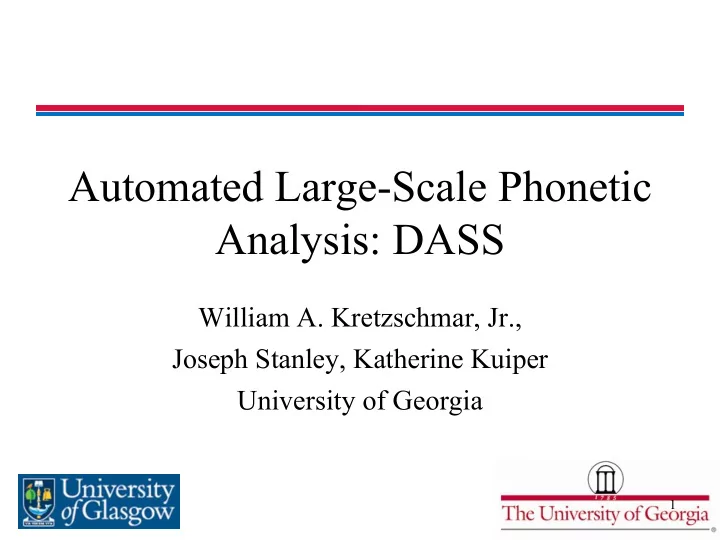

Automated Large-Scale Phonetic Analysis: DASS William A. Kretzschmar, Jr., Joseph Stanley, Katherine Kuiper University of Georgia 1
DASS • 64 interviews available on a portable USB drive • 370 hours of sound files--c. 200Gb, about 5000 files in all—plus metadata Map by Peggy Renwick • LICHEN user University of Georgia: Paulina Bounds, Steven Coats, interface software William A. Kretzschmar, Jr., Tony Snodgrass University of Oulu: Ilkka Juuso, Lisa Lena Opas- Hänninen, Tapio Seppänen
NSF grant for automated phonetic analysis • Automatically extract stressed vowels in the DASS inteviews • 1.5 million tokens overall • Extent of variation in vowels pronounced by one individual • Variation across regional and social categories of speakers • Challenge for generalizations based on small datasets, like Labov’s Southern Shift 3
Complex systems • Distributions in nonlinear Nonlinear A-curve pattern, patterns vowel in half • “Scale-free” distribution, i.e. the same pattern at every level of scale (overall, regional subsets, social subsets, individuals) • Big Data needed to show the patterns at all levels
Forced alignment with automatic formant extraction • Computational goal since 1970s • P2FA as early success (Yuan and Liberman 2008), used with automatic formant extraction in Evanini 2009. • P2FA has turned into FAVE (Rosenfelder et al. 2011) • DARLA (Dartmouth Linguistic Automation), Reddy and Stanford 2015.
Why DASS? • LAGS already widely used in analyses of Southern speech (e.g. Dorrill 2003, Feagin 2003, Schönweitz 2001, and Thomas 2005). • Thomas (2001) has demonstrated successful acoustic analysis of our old recordings. • The Atlas web site gets about a million accesses per year in recent years, so it is already a dataset that people want to use • DASS makes a good sample across the South
The pilot study (Renwick and Olsen 2015) • Ten speakers from section AK or LAGS, in Southeast Georgia, about 30 hours of audio. • Manual transcription of files, with semi-automated alignment using Perl and formant extraction in Praat, with manual adjustments • For one speaker (LAGS 195), the study found 76,735 words, as opposed to the 800+ targets that LAGS looked for: way more phonetic information!
Our progress: the short story • 35 part-time undergraduate transcribers • Transcriptions with Transcriber tool (available free online) • 3 graduate assistants and our administrative assistant monitor transcription and quality control • Forced alignment with DARLA, automatic formant extraction with modified FAVE
Initial results: æ Speaker 40 (F, W, 38, TN) Speaker 434 (M, B, 90, AL) tokens of æ tokens of æ
Initial results: i Speaker 40 (F, W, 38, TN) Speaker 434 (M, B, 90, AL) tokens of i tokens of i
Complex Systems and the Humanities http://emergence.libs.uga.edu
Thanks for your patience! Selected References Kretzschmar, William A., Jr., Paulina Bounds, Jacqueline Hettel, Lee Pederson, Ilkka Juuso, Lisa Lena Opas-Hänninen, Tapio Seppänen. 2013. The Digital Archive of Southern Speech (DASS). Southern Journal of Linguistics 37.2 (2013): 17-38. Reddy, Sravana and James Stanford. 2015. Toward completely automated vowel extraction: Introducing DARLA. Linguistics Vanguard . Renwick, Margaret, and Rachel Miller Olsen. 2015. Voices of coastal Georgia. Paper presented at the Acoustic Society of America (ASA 2015), Jacksonville. Rosenfelder, Ingrid; Fruehwald, Joe; Evanini, Keelan and Jiahong Yuan. 2011. FAVE (Forced Alignment and Vowel Extraction) Program Suite. http://fave.ling.upenn.edu.
Recommend
More recommend